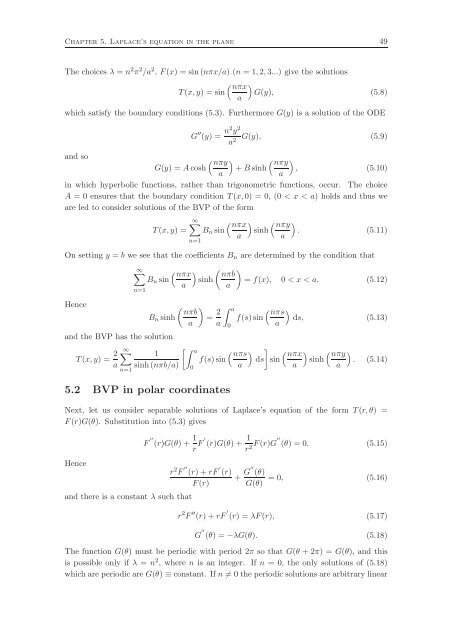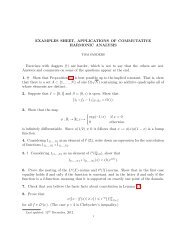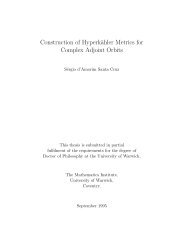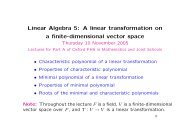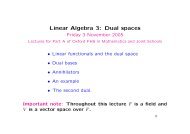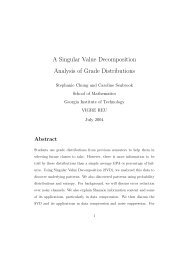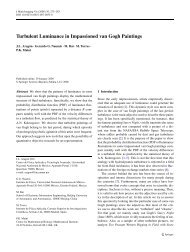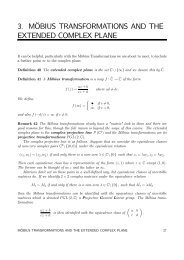Fourier Series and Partial Differential Equations Lecture Notes
Fourier Series and Partial Differential Equations Lecture Notes
Fourier Series and Partial Differential Equations Lecture Notes
Create successful ePaper yourself
Turn your PDF publications into a flip-book with our unique Google optimized e-Paper software.
Chapter 5. Laplace’s equation in the plane 49<br />
The choices λ = n 2 π 2 /a 2 , F(x) = sin(nπx/a) (n = 1,2,3...) give the solutions<br />
T(x,y) = sin<br />
nπx<br />
a<br />
<br />
G(y), (5.8)<br />
which satisfy the boundary conditions (5.3). Furthermore G(y) is a solution of the ODE<br />
G ′′ (y) = n2 y 2<br />
G(y), (5.9)<br />
a2 <strong>and</strong> so<br />
<br />
nπy<br />
<br />
nπy<br />
<br />
G(y) = Acosh +Bsinh , (5.10)<br />
a a<br />
in which hyperbolic functions, rather than trigonometric functions, occur. The choice<br />
A = 0 ensures that the boundary condition T(x,0) = 0, (0 < x < a) holds <strong>and</strong> thus we<br />
are led to consider solutions of the BVP of the form<br />
T(x,y) =<br />
∞ <br />
nπx<br />
<br />
nπy<br />
<br />
Bnsin sinh . (5.11)<br />
a a<br />
n=1<br />
On setting y = b we see that the coefficients Bn are determined by the condition that<br />
Hence<br />
∞ <br />
nπx<br />
<br />
nπb<br />
Bnsin sinh = f(x), 0 < x < a. (5.12)<br />
a a<br />
n=1<br />
<strong>and</strong> the BVP has the solution<br />
T(x,y) = 2<br />
a<br />
∞<br />
n=1<br />
<br />
nπb<br />
Bnsinh<br />
a<br />
0<br />
= 2<br />
a <br />
nπs<br />
<br />
f(s)sin ds, (5.13)<br />
a a<br />
0<br />
a 1<br />
<br />
nπs<br />
<br />
nπx<br />
<br />
nπy<br />
<br />
f(s)sin ds sin sinh . (5.14)<br />
sinh(nπb/a) a a a<br />
5.2 BVP in polar coordinates<br />
Next, let us consider separable solutions of Laplace’s equation of the form T(r,θ) =<br />
F(r)G(θ). Substitution into (5.3) gives<br />
Hence<br />
F ′′<br />
<strong>and</strong> there is a constant λ such that<br />
(r)G(θ)+ 1 ′<br />
F (r)G(θ)+<br />
r 1<br />
r2F(r)G′′ (θ) = 0. (5.15)<br />
r 2 F ′′<br />
(r)+rF ′<br />
(r)<br />
F(r)<br />
+ G′′ (θ)<br />
= 0, (5.16)<br />
G(θ)<br />
r 2 F ′′ (r)+rF ′<br />
(r) = λF(r), (5.17)<br />
G ′′<br />
(θ) = −λG(θ). (5.18)<br />
The function G(θ) must be periodic with period 2π so that G(θ + 2π) = G(θ), <strong>and</strong> this<br />
is possible only if λ = n 2 , where n is an integer. If n = 0, the only solutions of (5.18)<br />
which are periodicare G(θ) ≡ constant. If n = 0 the periodic solutions are arbitrary linear


